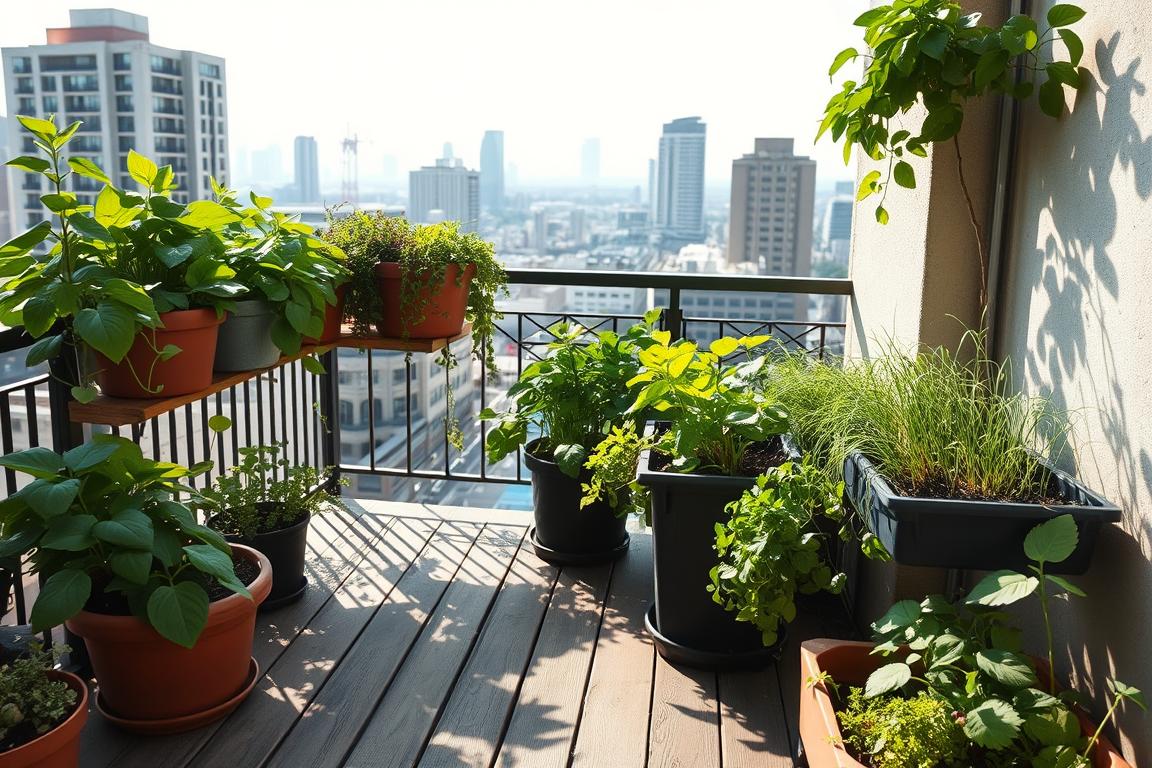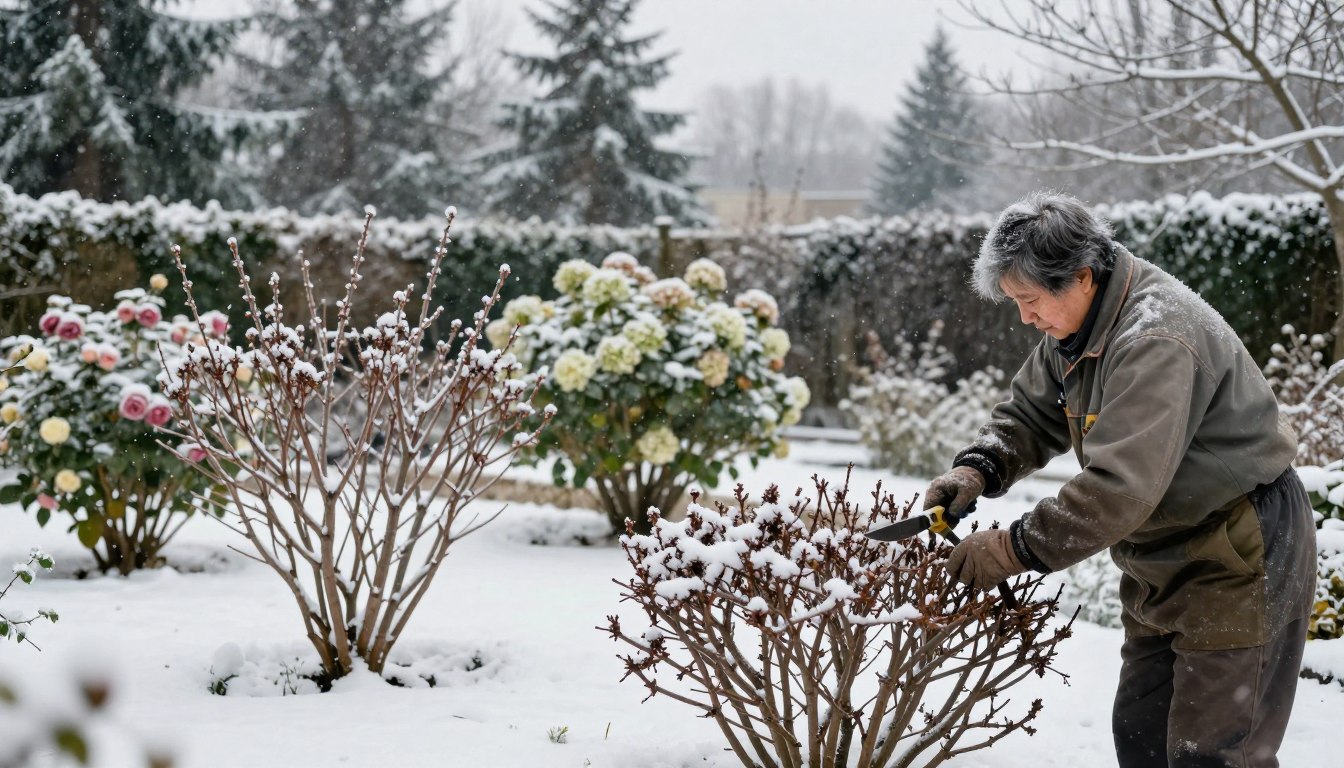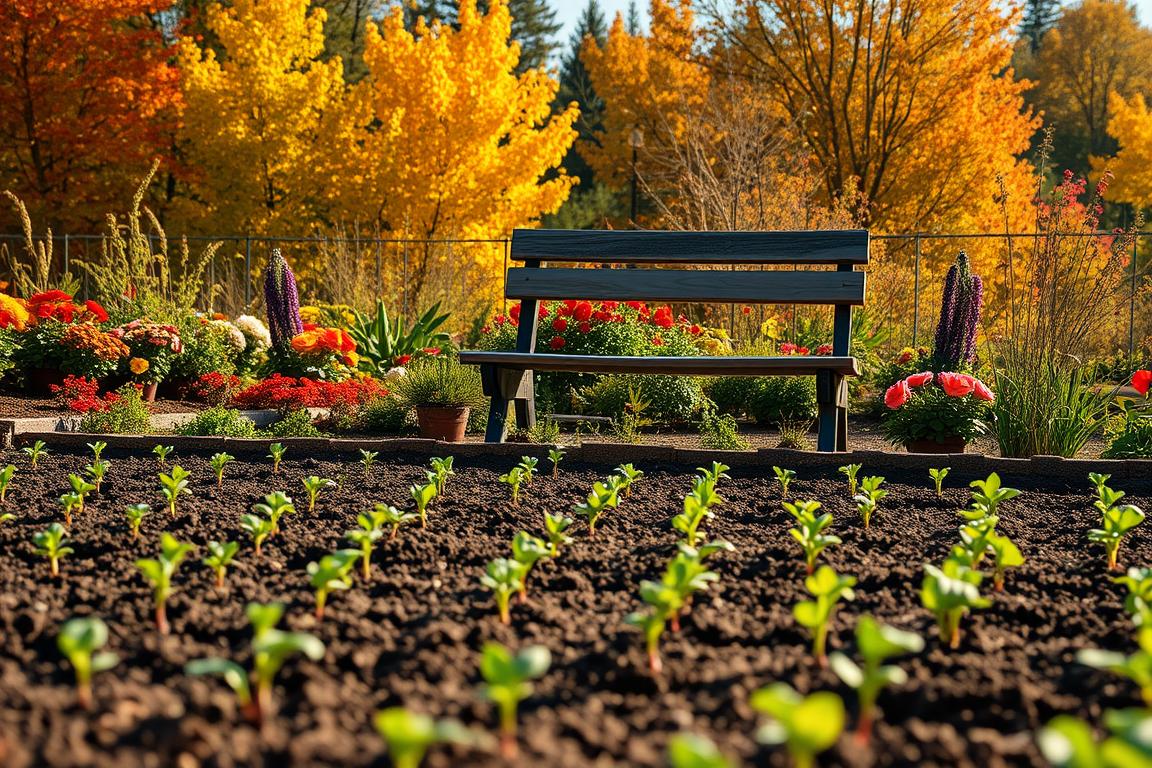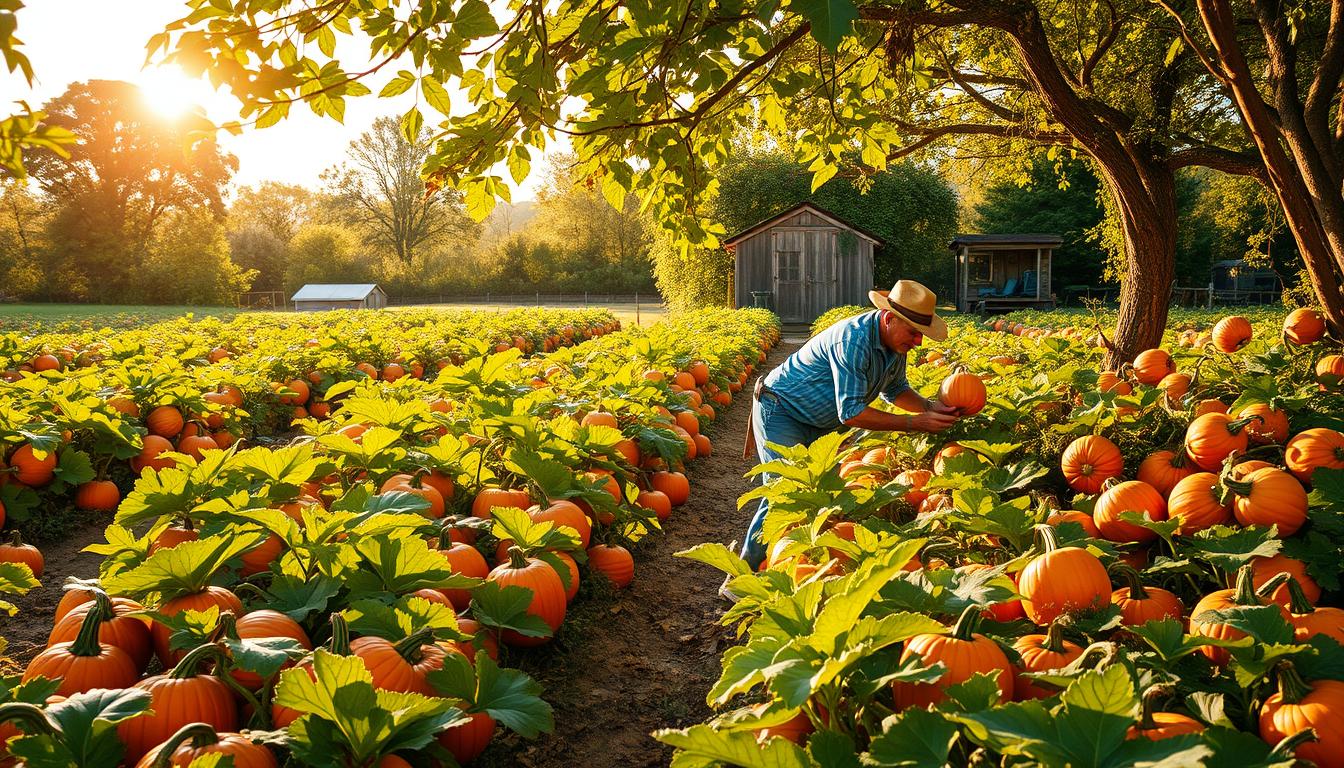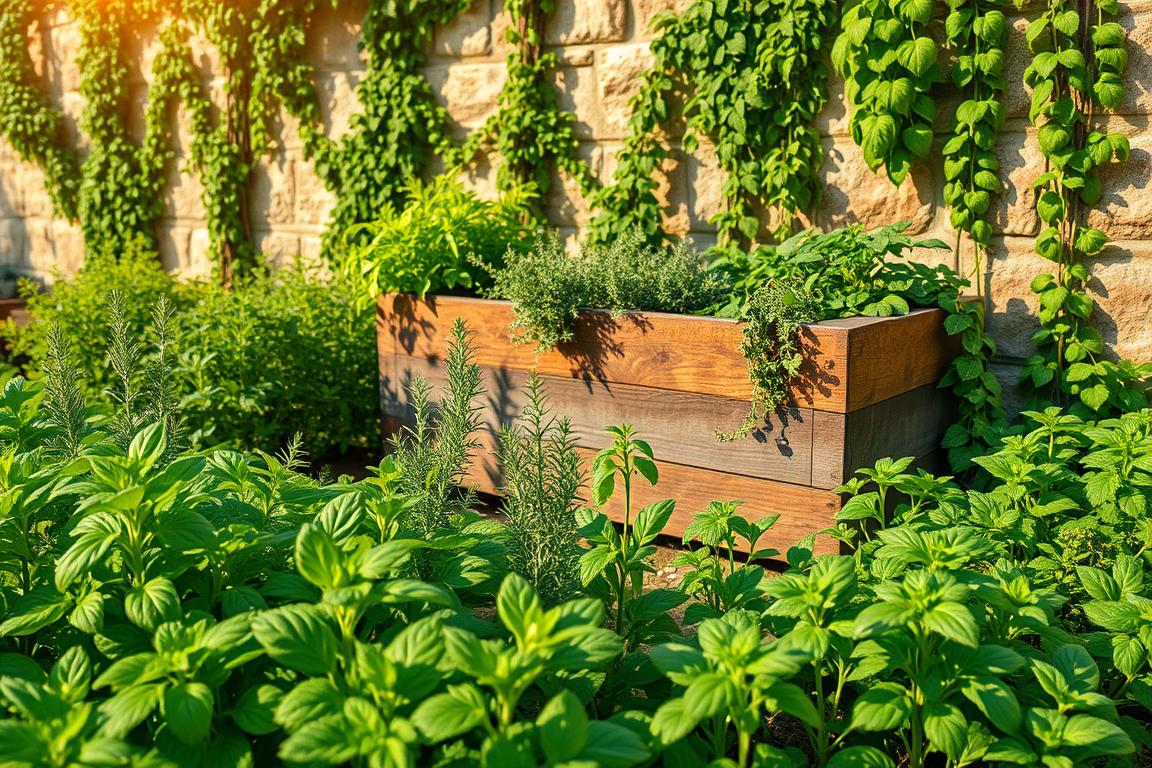We can turn our urban homes into green havens with the right apartment gardening tips. Gardening in the city is more than a hobby. It boosts our health and happiness by giving us fresh food and stress relief. By using small space gardening methods, we can enjoy gardening even in busy cities.
Balcony gardening and indoor container gardening are excellent starting points. With a bit of creativity, we can make our small apartments peaceful and rewarding. Whether it’s growing herbs or creating a lush indoor garden, the options are vast.
Key Takeaways
- Urban gardening improves health and well-being.
- Small space gardening techniques can be adopted for apartment living.
- Balcony and indoor gardening are great starting points.
- Apartment gardening can provide access to fresh produce.
- Gardening can be a stress-relieving activity.
The Essentials of Container Gardening for Apartment Life
Container gardening is a great way to garden in small spaces like apartments. We’ll cover the key aspects to start your apartment gardening journey.
Assessing Your Available Space
First, measure the space you have for gardening. Think about the size of your balcony, patio, or indoor area. Measure the space and decide on the number and size of containers that will fit comfortably. This helps you plan and avoid overcrowding, ensuring your plants thrive.
Understanding Light Conditions in Apartments
Light is key in container gardening. Apartments have different light conditions. Observe the light patterns in your space throughout the day to determine which areas receive the most sunlight. This helps choose the right plants, as some need full sun and others can handle shade or partial sunlight.
“The right plants can transform your apartment into a lush oasis, but it all starts with understanding your light conditions.”
Setting Realistic Gardening Goals
Setting achievable goals is crucial for a successful garden. Think about what you want to grow: herbs for cooking or ornamental plants. Start with a manageable number of plants and gradually expand as you gain experience. This keeps you motivated and lets you enjoy the journey.
By following these essentials, you’ll be well on your way to creating a thriving container garden in your apartment.
Choosing the Perfect Containers for Small Spaces
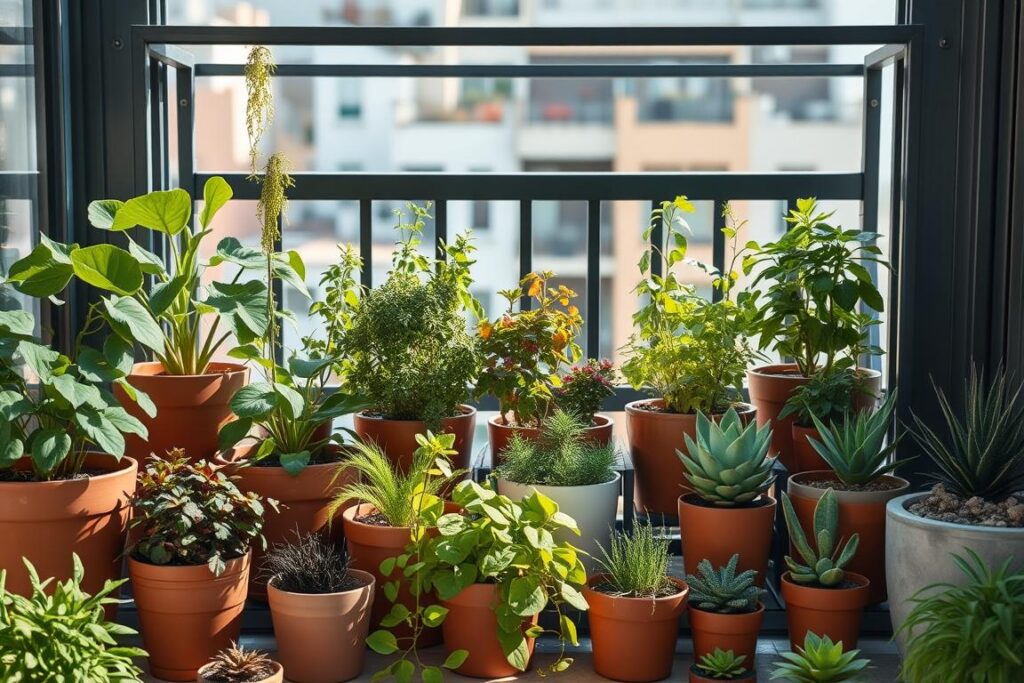
When you garden in an apartment, picking the right containers is key. The containers you pick will affect how well your plants grow.
Container Materials and Their Benefits
The material of your container matters a lot. You can choose from terracotta, plastic, wood, or metal. Terracotta pots are good because they breathe and look natural. Plastic is light and easy to clean. Wooden containers bring a rustic feel, and metal ones offer a modern look.
But, each material has its own set of issues. Terracotta can dry out too fast, and metal might rust if not treated right. Knowing these things helps you choose better for your garden.
Size and Depth Requirements for Different Plants
The size and depth of your containers depend on the plants you’re growing. Tomatoes and peppers need deeper pots for their roots. Herbs and succulents do well in shallower ones.
| Plant Type | Container Depth | Container Width |
|---|---|---|
| Tomatoes | 12-18 inches | 12-24 inches |
| Herbs | 6-12 inches | 6-12 inches |
| Succulents | 6-8 inches | 8-12 inches |
DIY Container Ideas for Budget Gardening
Building your own containers is fun and saves money. You can use old wooden crates, plastic tubs, or even boots. Just make sure they have holes for drainage to keep the soil dry.
“Gardening is a very noble profession — or a hobby, or a diversion, which brings us joy and comfort and helps to make our lives longer and better.” —
By picking the right containers and getting creative, you can have a great apartment garden. Whether you’re growing veggies, herbs, or flowers, the right containers will help your plants thrive.
Best Plants for Apartment Gardens
Choosing the right plants is key for a successful apartment garden. The right plants can make your indoor space feel like a lush oasis, even in the city.
Vegetables That Thrive in Containers
Container gardening is great for growing many vegetables. Leafy greens, cherry tomatoes, and peppers are top picks. They need little space and do well in containers with good drainage.
| Vegetable | Container Size | Sunlight Requirement |
|---|---|---|
| Cherry Tomatoes | 12-18 inches deep | 6+ hours |
| Leafy Greens | 6-8 inches deep | 4-6 hours |
| Peppers | 12-18 inches deep | 6+ hours |
Apartment-Friendly Herbs for Your Kitchen
Herbs are a fantastic addition to any apartment garden. They add fresh flavors to your cooking. Basil, cilantro, and parsley are easy to grow indoors. They need little care and can be ready to harvest in 2-3 weeks.
“Gardening is a love song, a duet between a human being and Mother Nature.” – Jeff Cox
Low-Maintenance Ornamentals for Beginners
For beginners, plants like snake plants, spider plants, and pothos are perfect. They handle different light levels and don’t need much water. They’re great for those with busy schedules.
Dwarf Varieties Perfect for Small Spaces
Small space gardening is easier with dwarf plants. These plants are made for container gardening and do well in tight spaces. They offer a lot of harvest or beautiful flowers.
By picking the right plants, you can enjoy gardening in even the smallest spaces. Whether you’re growing veggies, herbs, or flowers, there’s a lot to discover.
Creating a Thriving Balcony Garden
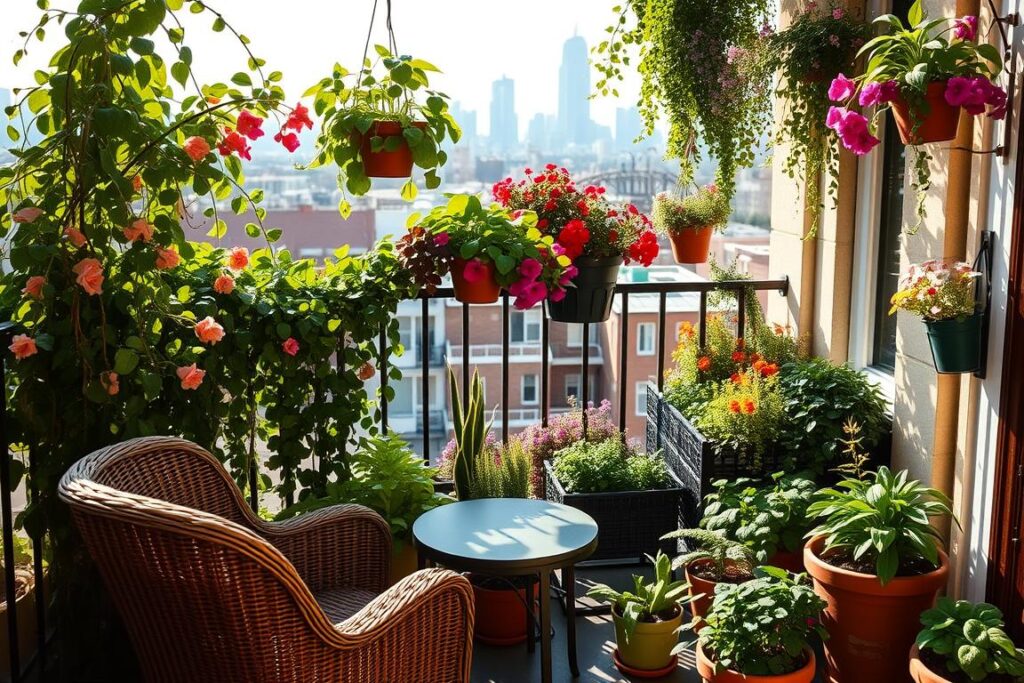
Turning your balcony into a lush oasis needs careful planning. We’ll show you how to make a beautiful and useful balcony garden. It will make your outdoor space even better.
Weatherproofing Your Balcony Garden
Protecting your plants and containers from the weather is key. Use durable materials for your containers. This helps them stand up to wind, rain, and extreme temperatures.
Think about using plastic or metal planters with built-in drainage. This stops the soil from getting too wet.
Weight Considerations and Safety
It’s important to think about the weight of your balcony garden. This keeps it safe and secure. Always check your balcony’s weight limit before adding heavy planters or containers.
Spread the weight out evenly. Using lightweight materials for your planters can also help avoid risks.
Maximizing Sun Exposure on Balconies
Getting enough sunlight is crucial for your plants’ health and growth. Place your plants where they get the most sunlight. If your balcony doesn’t get much sunlight, use reflective surfaces or mirrors to reflect light onto your plants.
By following these tips, you can make a thriving balcony garden. It will add joy and beauty to your outdoor space.
Space-Saving Vertical Gardening Techniques
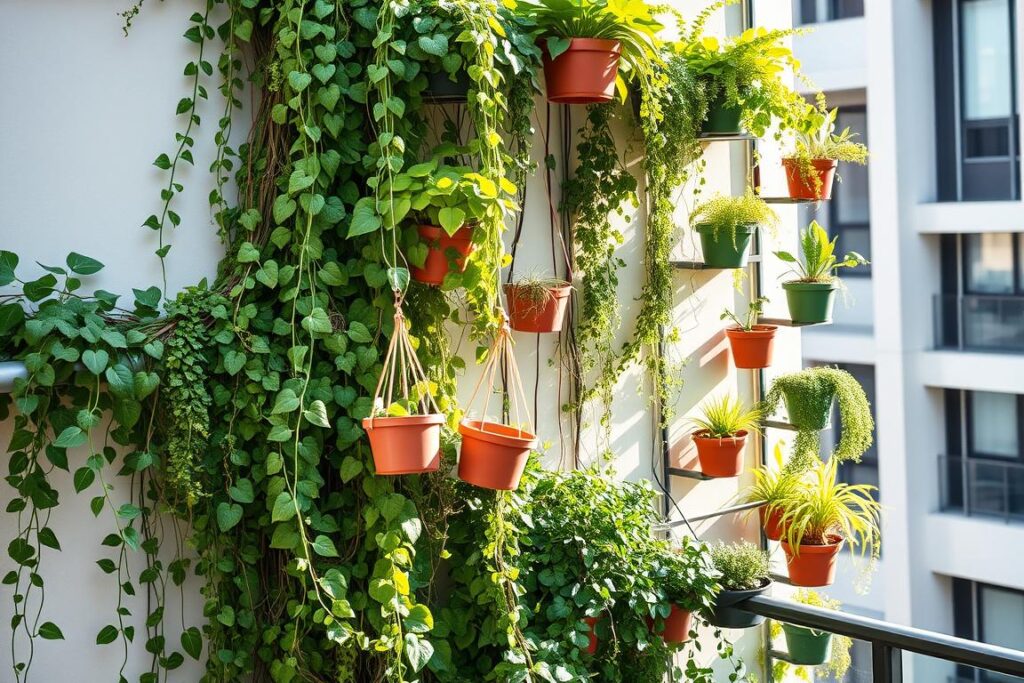
Vertical gardening is a great way to make small apartments look lush and layered. It uses wall space to grow plants, saving floor space.
Wall-Mounted Systems and Pocket Planters
Wall-mounted systems and pocket planters are great for adding greenery. They don’t take up much space. You can have a few pocket planters or a big wall garden. They’re perfect for herbs, succulents, and small plants.
Trellises and Climbing Plants for Height
Trellises help climbing plants grow up, using your ceiling space. Plants like ivy and roses do well on them. This not only saves space but also looks good.
Multi-Tiered Plant Stands and Shelving
Multi-tiered stands and shelving are also space-saving. They let you show off different plants at different levels. This is great for showing off ferns and flowering plants.
| Technique | Best For | Space Requirement |
|---|---|---|
| Wall-Mounted Systems | Herbs, Succulents | Minimal |
| Trellises | Climbing Plants | Moderate |
| Multi-Tiered Stands | Variety of Plants | Flexible |
Maintenance and Troubleshooting
Keeping your apartment garden in top shape is key. Regular care keeps your plants healthy and growing well in their containers.
Watering Solutions for Container Plants
Watering is crucial for container gardens. Too much water can cause root rot, while too little can stress plants. Check the soil by inserting a finger up to the first knuckle. If it’s dry, it’s time to water.
Using a potting mix that drains well can also help. This prevents the soil from getting too wet.
Dealing with Pests in an Apartment Setting
Pests like aphids, spider mites, and mealybugs can be a big problem. To fight them, use neem oil or insecticidal soap. Always check your plants and keep new ones separate to stop infestations.
Addressing Common Container Plant Problems
Container plants often face issues like nutrient deficiencies and poor soil. Table 1 lists some common problems and how to fix them.
| Problem | Cause | Solution |
|---|---|---|
| Yellowing Leaves | Overwatering or Nutrient Deficiency | Adjust watering schedule or fertilize |
| Slow Growth | Lack of Light or Nutrients | Relocate to brighter spot or fertilize |
By following these tips, you can keep your apartment garden healthy and thriving. Regular care and attention will help you tackle common problems and enjoy your container gardening journey.
Conclusion: Enjoying the Fruits of Your Apartment Garden
As we finish our guide to apartment gardening, we hope you’re eager to start. Growing plants in small spaces is good for your health and mind. It makes you feel accomplished and connected to nature.
With the right methods and patience, you can have a big harvest in a small space. Harvesting your own food is a happy moment. We’re sure you’ll love the fruits of your labor.
By using the tips from this article, you’ll create a thriving garden. It will bring you joy and satisfaction. So, start now, grow your plants, and enjoy all the benefits of apartment gardening!
FAQ
Q: What are the benefits of apartment gardening?
A: Apartment gardening boosts our health and happiness. It creates a calm spot in busy cities. Plus, we can grow our own food, helping the planet.
Q: How do I choose the right containers for my apartment garden?
A: Pick from terracotta, plastic, or wooden crates for your garden. Think about the size and depth each plant needs for growth.
Q: What are the best plants for apartment gardens?
A: Leafy greens, cherry tomatoes, and herbs like basil are great for small spaces. Look for dwarf varieties that grow well in tight spots.
Q: How do I create a thriving balcony garden?
A: Make your balcony garden strong by weatherproofing it. Think about weight and safety. Use containers and vertical gardening to use every inch of space.
Q: What are some space-saving vertical gardening techniques?
A: Use wall systems, trellises, and multi-tiered stands to save space. These methods let you grow many plants in a small area.
Q: How do I maintain my apartment garden?
A: Keep your garden healthy by watering right, controlling pests, and solving common issues. Follow these tips to ensure your plants thrive.
Q: Can I grow vegetables in containers?
A: Yes, you can grow many vegetables in containers. Try leafy greens, cherry tomatoes, and other small varieties. With care, you’ll have a great harvest.
Q: How do I deal with pests in my apartment garden?
A: Use natural pest control like neem oil or insecticidal soap. Regularly check your plants and keep your garden clean to prevent pests.


